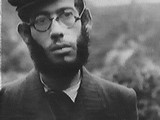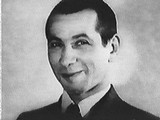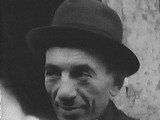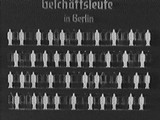|
The circumstances of the genesis of "The Eternal Jew" are not
particularly known - not even by the scholars of the Holocaust. On
November 10, 1938, the evening after the Reichscristallnight and
exactly 20 years after Hitler's decision to become a politician - at
least according to his own recollection and his own myth of his
"mission" - the German Führer gave an important speech on the
future role of propaganda. Although he did not refer directly to either
the events of the Reichscristallnight nor to the Jewish Question in
general, the whole speech can be seen as a commentary to what he saw as
the lacking support of the German public for the pogrom. Hitler
attacked the propaganda makers for not having understood his strategy -
which aimed at war - and he made it totally clear to his audience
exactly what he awaited from them in the future:
The reason why I for many years only spoke about peace was that I
was forced to do it. But gradually it became necessary to influence the
German people psychologically and slowly make them recognize, that
there really do exist certain things, with which you have to cope by
means of violence, when they cannot be solved by peaceful means. But to
do this, it was necessary not to make propaganda for violence as such,
but to explain certain matters of foreign policy to the German people
in such a way, that the inner voice of the people all by itself
gradually would call for violence. This meant, consequently, to explain
certain events in a way which gradually, and totally automatically,
would lead to a conviction in the brains of the broad masses: What one
cannot solve benignly, one has to solve by means of violence, as it
cannot go on like this.
The message of Hitler's critical remarks was most certainly
understood by Joseph Goebbels, who now for the first time decided to
use the film medium as a tool to instigate antisemitism within the
German people. Earlier, he had - as the person responsible for Nazi
film production - preferred other topics, e.g. entertainment and more
"positive" representations of Nazi world view. But immediately after
Hitler's speech he ordered the production companies to submit
 |
antisemitic film scripts. His wish for a "documentary," however, could
not be satisfied until after the campaign in Poland in September 1939,
because there was archive footage neither of Jews who looked like the
Nazi stereotype of Jews, nor of services in the synagogue, nor of
ritual slaughter.
In Goebbels' diary as well as in other sources we can follow the
production of exactly this film - The Eternal Jew - which right from
the beginning and in accordance with Hitler's demands was intended to
be the final public legitimation of antisemitism. There are strong
reasons to believe that the film and its genesis reflect the very
decision making process which led to the Holocaust - especially because
the final version of the film can only be interpreted as a deliberate
call for annihilation. This is particularly obvious in the
cross-cutting between the ritual slaughter - staged and presented as
cruelty to animals, and as the visual proof of Jewish "inhumanity" -
and a re-cut version of Hitler's notorious prophecy in his
speech
in the Reichstag on January 30, 1939, that a future war would lead
to the "annihilation of the Jewish race in Europe."
In order to have as powerful an effect as possible, Goebbels had
ordered the film recording of ritual slaughter in the Ghetto of Lodz,
and when he saw the rushes on October 16, 1939, he wrote in his diary:
These scenes are so brutal and cruel in their many details, that
one's blood runs cold. One shudders at such barbary. These Jewry must
be annihilated.
On October 28 he showed the rushes at Hitler's dinner-table, and
it should be remembered that Hitler was a fanatic vegetarian. Those
present "were all deeply shocked." Three days later Goebbels himself
visited the Ghetto of Lodz and commented upon his impression in his
diary:
It is indescribable. They are no longer human beings, they are
animals. This is no longer a humanitarian question, but a task for the
surgeon. Here one has got to cut, and as radically as possible. Or
Europe will one day collapse from the Jewish disease.
Goebbels made the idea of a genocidal solution of the Jewish
problem saturate the whole film, which must be considered as his
personal attempt to make Hitler himself draw the "natural"
consequences of his own exterministic ideology. The film was tested
and recut according to Hitler's wishes several times, before the
Führer finally endorsed it for public showing, probably on May
20, 1940 - the day, when German troops reached the English Channel and
thus made the fall of France a matter of time.
However, it was several months before "The Eternal Jew" began
to be distributed, because Goebbels awaited the finalizing of yet
another important part of his antisemitic propaganda package: the
feature film "Jud Süß."
The latter was intended to inflame antisemitic feelings, which then
were to be "proven by facts" in the "authentic film document." "Jud
Süß" had its opening night, with much publicity, at the film
festival in Venice on September 6, 1940, while "The Eternal Jew" was
shown to the top people of the Third Reich two days later as an example
of the new type of propaganda which should prepare the German public to
the continuation of the war. Now it was impossible to anyone present to
be ignorant of the fact that the war was not just a "normal" war. It
was an outspoken racial war against "alien world views."
"The Eternal Jew" finally had its public premiere on November 28,
1940, when the director, Fritz Hippler, in an interview broadcast
all over Germany, claimed that the film contained the very
proof for Hitler's prophecy from 1939. Hippler also pointed
out, that the premise of the prophecy, the war, had become a reality.
Immediately after the film had been shown all over Germany, Hitler
began to recall the prophecy in his speeches and in private
conversations, thus clearly verbally endorsing the message of the film
about the necessity of launching the genocide.
In other words, it can be argued that "The Eternal Jew" was Hitler's
promulgation to the public about what was to be expected in the war
against the Jews, in which he used the emotional power of modern
reality-like mass-media in order to transfer his decision to ways of
thinking and actions within perpetrators and bystanders. The German
people should - just as he had outlined in his critique of the German
propaganda after the Reichscristallnight - all by themselves and by
their own conviction take the decision of systematically killing the
European Jews:
What one cannot solve benignly, one has to solve by means of
violence, as it cannot go on like this.
From a purely historical perspective, "The Eternal Jew" is
undoubtedly a very important means for the understanding of both Nazism
and the Holocaust. No other single historical source gives so much
information and insight about Nazi ideology and world view as this
film. From my own experience of more than twenty years of teaching I
can certify that students on both the high-school and university level
can pick up all major aspects of the mentality of the Third Reich,
without difficulty, through the analysis of this film.
In several seminars in both Denmark and Germany, I have also been
able to witness how this film succeeded in making the apparently
distant Nazi ideology a relevant question to even young people of
today. During a bit more than one hour they are taken back more than
fifty years, and get a personal experience of what it could have been
like to have lived in the Third Reich - or how it could have been to
have been its unhappy neighbours and scapegoats.
At the Historical Institute at the University of Copenhagen, a
project was started in 1970 to establish the methodological principles
for source-critical editions of important film documents. One of the
chosen films was "The Eternal Jew" - and after many different kinds of
troubles I was able to publish the source-critical edition of the film
with the Institute for the Scientific Film in Göttingen in 1995.
However, because it quickly became clear to us back in the early
1970s that this film contained unique paedagogical examples of all
kinds of audio-visual manipulation techniques, the project got an
additional perspective: We wanted to find out whether the film - or
parts of it - could be used to teach mass media techniques outside the
university, especially on the high-school level.
First and foremost, we had to check how the young people of today
were influenced by the film. In our eyes it was both lumpy and
grotesque, and we believed that it would achieve exactly the opposite
effect as originally intended. This opinion could, however, derive
from our knowledge of the Holocaust, and we wanted to have our thesis
confirmed by empirical investigations about the actual reactions by
the young viewers. Obviously, we did not wish to create any kind of
potential antisemitism.
 |
Between 1973 and 1975, we tested "the Eternal Jew" on 1200 Danish
high-school students between 16 and 19 years old, giving them a
questionnaire with 25 questions. We had built in a couple of "traps" in
order to reveal the sincerity of the answers, which were given
anonymously. The result was both evident and encouraging. Just one
single person related that he had changed his opinion in a negative way
- and an analysis of his other answers proved that he either was a
latent antisemite already before he saw the film or a mere provocateur.
This investigation showed beyond any reasonable doubt that our
fear and the fear of other experts of unintentionally creating an
antisemitic sentiment among Danish high-school students was without
foundation. If the film did alter somebody's opinion of Jews, it was
definitely not along the direction which Goebbels had intended.
The film had instead a quite different effect: The experience of
seventy minutes of Nazi hate propaganda suddenly opened the students'
eyes to the mental processes inside the ordinary German in the Third
Reich. The students said that they now had felt what it was like to
live in a totalitarian society - and how difficult it must have been
actively to oppose the bombardment of the media. Some of them even
wrote that they felt sorry for the Germans, and they started to reason
about the question of guilt after the Holocaust. They had suddenly been
made knowledgable about the efficiency and the totality of the Nazi
propaganda which had brainwashed the German public.
But what was the biggest surprise to us, was the capability of the
young people to be critical of what they saw. Because they - contrary
to most members of the research team - had grown up with television,
they were able to handle the contents of the film in a much more
mature way than we had ever expected. They were able to express
impressions and points-of-view on different levels and they had also
the ability to reflect a more general level as well as to draw their
own conclusions.
Despite this encouraging result the project and the use of the film
stalled for a couple of years. One of the reasons for this was that the
members of the group got their degrees and jobs elsewhere. Another was
that the German authorities made the rules for access to the film more
rigorous. The difficulty of renting a copy was and is - together with
the inexperience of most historians in using film as historical source
material - probably the main reason that this film is still virtually
unknown to many scholars of the Holocaust.
It should, however, be mentioned, that during the last two years I
have taken up the project again and have carried out similar surveys
in Denmark and Germany during presentations in high-schools and on
universities. The results in both countries are almost identical with
the results from the mid-seventies. There is only one marked
difference. The psychological engagement is much bigger today than
twenty years ago, especially in the former DDR, where there is an
outspoken need to come to terms with the inheritance of both Nazi and
Communist ideology. This fact has led the Bundeszentrale für
politische Bildung to distribute copies of my source-critical edition
for free - and it is going to arrange a seminar this autumn in
cooperation with the German Association of Teachers in History on the
possibilities of using the film in both teaching History of Nazism and
Political Education.
Daniel Jonah Goldhagen's book Hitler's Willing
Executioners has led to another intense debate on the reasons
behind the Holocaust and once more directed the interest to the guilt
of the ordinary German. The German journalist Josef Joffe from the
Süddeutsche Zeitung has pointed to the strange discrepancy
between the negative evaluation by most scholars and the positive,
almost masochistic, reception the book got from the general public in
Germany. Joffe argues that Goldhagen's perspective - to describe the
perpetrators as "ordinary human beings, perhaps like you or I" - is
important, but that the main reason for its acceptance by the public is
the "distance that separates the German of today from the darkest of
all past periods" in combination with the successful "sterilization of
the past" by German historical science. With his detailed case-studies
and powerful language Goldhagen succeeded in breaking the pleasant
model of interpretation, which projected all guilt upon Hitler and his
followers. The strong emotional character even made the liberal symbol
figure of the German press, Marion Gräfin von Dönhoff, wonder
in "Die Zeit" whether there could be a risk that the book would "wake
up an antisemitism which has been sleeping for a long time." But Joffe
was able to establish that her fear had been without reason: "Goldhagen
has come and gone and the dogs never raised an eyebrow."
Why did it happen in Germany? is one of the crucial questions in
Goldhagen's book. What he demonstrates is that an exterministic
attitude towards the Jews did exist among the ordinary Germans who
participated in the Holocaust, and he finds the cultural and historical
roots to this attitude in a specific German antisemitic tradition. But
he does not - as many of his critics have pointed out -
account for the responsibility which has to be put upon the Nazi
system within which the perpetrators acted. And what about the Nazi
propaganda - and indoctrination system? Or what about the outspoken
Nazi belief in - and support to - physical violence beyond all
restrictions and values?
It is exactly these psychological and socio-psychological factors
which become visible in "The Eternal Jew." The film demonstrates in an
overwhelming way how cultural stereotypes suddenly can develop into
paranoid arguments for murder. These - still highly emotional -
effects on the viewer derive from the fact that it is presented and
conceived as "real," as an authentic document produced by the Nazi
themselves, for the general public, as legitimation of their world-view.
It forces everybody to take an individual position regarding Nazism
and antisemitism.
Are we still to be afraid of this Hitler's public call for the
annihilation of the Jews?
My answer is a convinced no. The showing of the film forms
instead a ominous warning to what can happen when a "produced reality,"
in a reality-like medium, is perceived as reality itself. In this
connection, "The Eternal Jew" is the predecessor of all the TV
propaganda which - e.g. in former Yugoslavia - has aroused and
legitimized genocide even in our time.
A study of this film and comparison with its later successors of
inhumanity can - in the light of its consequences - help us to
disclose the psychological patterns behind genocidal mentality, which
should be the fundamental aim for all teaching about the Holocaust.
Thank you very much for your attention!


Additional information about the movies referenced is available at
the
Internet Movie Database:
| 





